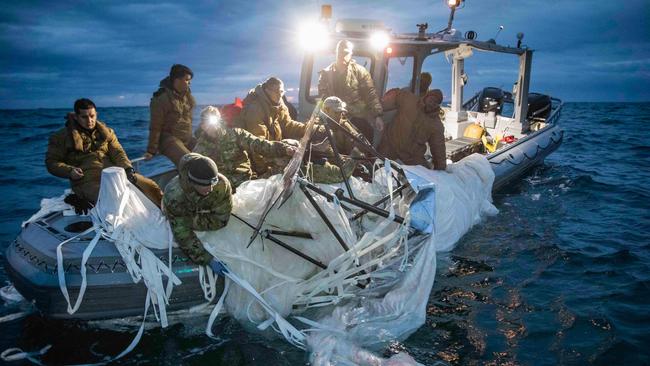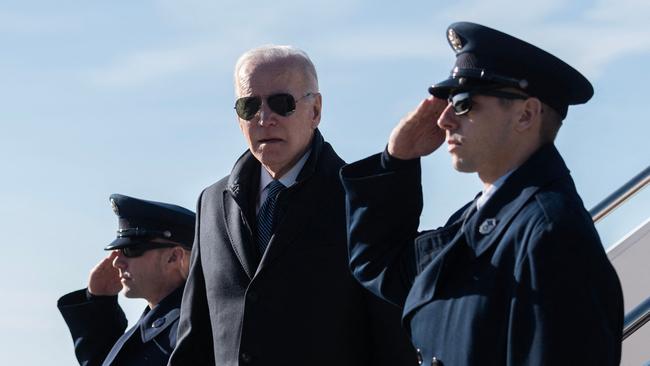Beijing accuses US of ‘illegally’ flying balloons in Chinese airspace
The White House addressed stunning accusations from Beijing of the US sending more than 10 balloons into Chinese airspace, as relations reach new lows over the spy satellites.
World
Don't miss out on the headlines from World. Followed categories will be added to My News.
China accused the United States on Monday of flying balloons over its territory, hitting back against Washington’s claims that Beijing has been sending alleged surveillance aircraft.
Relations between the United States and China have further soured after Washington shot down an alleged Chinese espionage device in early February, which Beijing has insisted was for civilian purposes.
A number of other such devices have since been shot down over the US and Canada, though Beijing has only admitted that the first was one of its own.
Over the weekend, Chinese state-affiliated media reported that an unidentified flying object had been spotted off the country’s east coast – and that the military was preparing to shoot it down.

Beijing on Monday declined to comment on that report, only referring journalists to the defence ministry, which did not respond to requests for comment from AFP.
But it did accuse the United States of sending more than 10 balloons into its airspace since January 2022.
“It’s not uncommon as well for the US to illegally enter the airspace of other countries,” foreign ministry spokesman Wang Wenbin said during a briefing.
“Since last year alone, US balloons have illegally flown above China more than 10 times without any approval from Chinese authorities.”
Asked how China responded to those alleged incursions, Wang said Beijing’s “handling (of these incidents) was responsible and professional”.
“If you want to know more about US high-altitude balloons illegally entering China’s airspace, I suggest you refer to the US side,” he added.
The White House denied Beijing’s accusation that the United States has been sending balloons over China to conduct surveillance.
“Any claim that the US government operates surveillance balloons over the PRC is false,” National Security Council spokesperson Adrienne Watson said on Twitter, adding that it is the People’s Republic of China “that has a high-altitude surveillance balloon program for intelligence collection”.
“This is the latest example of China scrambling to do damage control,” she said.
“It has repeatedly and wrongly claimed the surveillance balloon it sent over the US was a weather balloon and has failed to offer any credible explanations for its intrusion into our airspace, airspace of others.”
National Security Council spokesman John Kirbys said the US was “not flying balloons over China”, and added that the latest objects shot down might have had civillian or academic purposes.
“There could be completely benign and totally explainable reasons for why these objects are flying around up there,” he said on MSNBC.
US SHOOTS DOWN ANOTHER FLYING OBJECT
US warplanes have shot down another flying object, this time over Lake Huron on the US-Canadian border, the fourth in a dramatic series that began with the downing of a suspected Chinese spy balloon a week ago.
Jittery Americans have been watching the skies as the mysterious incursions unfolded against a backdrop of acute tensions with China - although only the first object has so far been attributed to Beijing.
“The object has been downed by pilots from the US Air Force and National Guard,” Representative Elissa Slotkin of Michigan, which lies south and west of Lake Huron, tweeted on Monday morning (AEDT).
Another Michigan politician, Representative Jack Bergman, said the US military had “decommissioned” an object over the lake.
There was no immediate confirmation from the Pentagon but Slotkin said she had received a call from the Defense Department about this new object.
“We’ll know more about what this was in the coming days, but for now, be assured that all parties have been laser-focused on it from the moment it traversed our waters,” she tweeted.

It comes as the US and Canada were working to recover the remnants of three mysterious objects shot down over their territory, amid growing jitters that resulted in several brief air-space closures in recent days.
Reflecting the heightened state of alert, US authorities on Sunday first announced an airspace closure over Lake Michigan, near the border with Canada, and then lifted the restriction.
A similar closure Saturday over Montana led to the scrambling of US fighter jets but it too was eventually lifted.
Canadian Prime Minister Justin Trudeau meantime was heading to the western Yukon territory, where an unidentified object was shot down a day earlier.
The dramatic succession of shootdowns has roiled already tense US-Chinese relations.
A senior Republican on Sunday accused Beijing of “an act of belligerence” regarding the first balloon, shot down February 4 off the US East Coast after officials said it was engaged in spying.
“It was done with provocation to gather intelligence data, and collect intelligence on our three major nuclear sites,” Michael McCaul, chairman of the House Foreign Affairs Committee, told CBS.
US Senate Majority Leader Chuck Schumer, among senior lawmakers who received a government briefing, told ABC the two latest objects both appeared to be balloons, but “much smaller than” the first large one.
Mr Trudeau’s visit comes a day after a US F-22 jet, acting on orders from the prime minister and US President Joe Biden, downed a “high-altitude airborne object” over the Yukon, about 160km north of the border.
Canadian officials described it as small and cylindrical, roughly the size of a Volkswagen car.
The Trudeau visit had been planned earlier - he was already scheduled to meet with Indigenous leaders - but he said Sunday in Ottawa that some of those leaders might have been affected by falling debris from the object shot down Saturday.
Recovery teams backed by a Canadian CP-140 patrol aircraft were continuing their search Sunday for debris in the Yukon, officials said.
US teams were struggling with Arctic conditions as they searched near Deadhorse, Alaska, where an object was shot down Friday.
Operations were also continuing off the South Carolina coast, where the past week’s drama climaxed when the initial large balloon was shot down on February 4.
HOW CHINA’S SPY BALLOON SPARKED INTERNATIONAL INCIDENT
The Chinese government is spying on the United States around the clock.
It has 260 satellites providing intelligence and surveillance from space. Hackers are infiltrating American infrastructure and institutions. Human agents operating in the US are targeting classified information, military technology and trade secrets.
So why did a balloon – ostensibly the most basic part of China’s espionage arsenal – spark an international incident between the two superpowers? Was it all a lot of hot air?
Richard Fontaine, a former US State Department official, gives two reasons why the balloon episode “could hardly have been better designed” to stoke concerns about China.
Firstly, he says the made-for-TV saga opened the eyes of Americans to the Chinese government’s espionage in a way other “largely unseen” forms of spying could not.
Secondly, he points out that Americans – much like Australians – are “exquisitely sensitive to physical violations of their sovereignty” because they are surrounded by oceans and friendly neighbours.
“And so while no one could have predicted it, China’s balloon may well spur America’s awakening,” the boss of the Center for a New American Security declared.
Indeed, President Joe Biden’s decision to shoot down the balloon was only the beginning of what has been a surprisingly forceful and forward-leaning response.

US Secretary of State Antony Blinken cancelled an icebreaking trip to Beijing, where he was due to meet President Xi Jinping, over what he blasted as “an irresponsible act”.
His deputy Wendy Sherman then briefed dozens of US allies that the balloon was part of a Chinese military fleet that had flown over more than 40 countries.
“ (T) he United States was not the only target of this broader program, which has violated the sovereignty of countries across five continents,” Blinken said.
US intelligence agencies confirmed at least five Chinese spy balloon flights had occurred over their territory in recent years, as top air force commander General Glen VanHerck acknowledged a “domain awareness gap” meant they were missed in real time.
After navy sailors pulled balloon debris from the ocean, the Biden administration shared further intelligence on Friday (AEDT) to reject China’s claim that it was conducting weather research. In fact, it carried antennas capable of tapping communications signals and solar panels to power “multiple active intelligence collection sensors”.
US officials also explained that spy balloons which hovered over areas could produce clearer images than satellites in constant motion, while also more easily evading detection.
Taken together, the US response encouraged viewing the balloon not as a one-off oddity, but as a significant new wrinkle in the Chinese government’s intelligence and defence strategy. In China, military experts have been saying as much for years.

The People’s Liberation Army Daily, the Chinese military’s newspaper, published a story in 2020 declaring near space – the layer of the atmosphere between 20km and 100km above earth – was a “new battleground in modern warfare”. The next year, it foreshadowed balloons becoming “like submarines in the depths of the ocean, a chilling hidden killer”.
Chinese researchers have also suggested balloons could be used not just for intelligence-gathering, but to launch hypersonic weapons.
These musings further undermine the Chinese government’s claim that the balloon over the US was a civilian craft. That said, it remains unclear how the flight went so wrong.
Hudson Institute senior fellow Rebeccah Heinrichs suggests Xi was mocking the US with a “blimp-sized middle finger to President Biden’s efforts to smooth relations”. Alternatively, she says perhaps the balloon simply flew off course.
“For the world’s most sophisticated techno-authoritarian state that boasts of its control and lack of errors, accidentally losing a valuable surveillance blimp the size of three school buses over the territory of your number one rival is quite the accident,” the defence expert said.
Accident or not, the US is now trying to use the incident to embarrass China into curbing its surveillance program. Perhaps even more importantly, the Center for Strategic and International Studies’s senior adviser Scott Kennedy says it highlights the need to rebuild lines of communication between the superpowers.

China’s defence minister refused to speak to US Defence Secretary Lloyd Austin after the balloon was shot down, and Chinese officials later threatened unspecified retaliatory action.
Kennedy argues Blinken’s visit should be quickly rescheduled, given the need for the US to “simultaneously spotlight Chinese misdeeds and sit across from them at the negotiating table” so that competition can occur while conflict is avoided.
In Sky News Australia’s new documentary, “Are We Ready for War”, former president Barack Obama’s defence secretary Leon Panetta says Xi’s goal is for China “to become the predominant power in the world”.
He warns that “represents trouble for both Australia and the United States”.
The late senator and former major general Jim Molan, speaking in his final interview, agreed.
“We’ve got a period of time now where we must prepare for the worst case,” he said.
- additional reporting AFP
More Coverage
Originally published as Beijing accuses US of ‘illegally’ flying balloons in Chinese airspace





